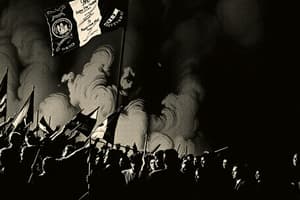Podcast
Questions and Answers
What significant change occurred in individuals' status after the French Revolution?
What significant change occurred in individuals' status after the French Revolution?
- Individuals were assigned a specific social rank at birth.
- Individuals gained citizenship with inalienable rights. (correct)
- Individuals became subjects of the monarchy.
- Individuals lost their rights to participate in government.
What role did Enlightenment ideals play in the French Revolution?
What role did Enlightenment ideals play in the French Revolution?
- They emphasized the importance of religious principles.
- They reinforced the power of the monarchy.
- They contributed to the rise of liberal democracy. (correct)
- They promoted the concept of a social hierarchy.
What painting symbolizes the ideals of freedom during the French Revolution?
What painting symbolizes the ideals of freedom during the French Revolution?
- The Coronation of Napoleon
- The Death of Sardanapalus
- The Oath of the Horatii
- Liberty Leading the People (correct)
What was one reason for the economic turmoil leading up to the French Revolution?
What was one reason for the economic turmoil leading up to the French Revolution?
How did the French Revolution affect the church's position in society?
How did the French Revolution affect the church's position in society?
What consequence did the restructuring of subjecthood have on individuals' identities after the revolution?
What consequence did the restructuring of subjecthood have on individuals' identities after the revolution?
What defines Humanism as described in the context of the period?
What defines Humanism as described in the context of the period?
What primary theme does David Hammons explore in his works?
What primary theme does David Hammons explore in his works?
Which of the following factors did NOT contribute to the French Revolution?
Which of the following factors did NOT contribute to the French Revolution?
According to Kant, how is 'true aesthetic taste' characterized?
According to Kant, how is 'true aesthetic taste' characterized?
What does Pierre Bourdieu suggest about taste?
What does Pierre Bourdieu suggest about taste?
How does the modern artist differ from the artist in antiquity, according to the content?
How does the modern artist differ from the artist in antiquity, according to the content?
What was Immanuel Kant's view on the nature of beauty?
What was Immanuel Kant's view on the nature of beauty?
Which statement reflects the properties of art as described in the content?
Which statement reflects the properties of art as described in the content?
What does the phrase 'a harmonious free play' refer to in Kant's theory of aesthetics?
What does the phrase 'a harmonious free play' refer to in Kant's theory of aesthetics?
In modern times, how is taste viewed differently compared to antiquity?
In modern times, how is taste viewed differently compared to antiquity?
What characterized the artist's authority in liberal democracy and capitalism?
What characterized the artist's authority in liberal democracy and capitalism?
How did the revolutionaries in July 1789 view their actions in relation to symbols of power?
How did the revolutionaries in July 1789 view their actions in relation to symbols of power?
What was a result of the material transformation of the statue of Louis XV?
What was a result of the material transformation of the statue of Louis XV?
What does 'iconoclasm' refer to?
What does 'iconoclasm' refer to?
What role did church bells play during the revolution?
What role did church bells play during the revolution?
Which aspect distinguishes 'signature' in the context of art and graffiti?
Which aspect distinguishes 'signature' in the context of art and graffiti?
What was a significant outcome of the protests influenced by the American Revolution?
What was a significant outcome of the protests influenced by the American Revolution?
What is a key characteristic of graffiti and street art as discussed?
What is a key characteristic of graffiti and street art as discussed?
Study Notes
Restructuring of Subjecthood
- The French Revolution, 1789, transformed the social hierarchy and restructured the concept of “subjecthood”.
- Before the revolution, people were born into a specific rank within a rigid social structure.
- The revolution ushered in liberal democracy, giving citizens inalienable rights, and participation in government.
- The French Revolution, along with the American Revolution, popularized the idea of freedom and equality.
- “Free will” and individual rights became central to the modern conception of the individual.
Art and the Modern Subject
- In the context of liberal democracy and capitalism, individuals have the right to property and contract.
- This concept applies to artists who have full authority over their work, free from the constraints of the church or monarchy.
- The individual artist is seen as a "genius" whose creative work is valued and circulated in the free market.
Symbol Transformation
- The French Revolution saw the material transformation of symbols of power.
- The headless statue of Louis XV was melted down to create cannons, highlighting the shift from monarchy to a democratic republic.
- The Bastille, a symbol of royal tyranny, was demolished, becoming an emblem of freedom.
Iconoclasm and Vandalism
- Iconoclasm is the destruction of religious images or symbols.
- Vandalism is the destruction of property.
- The French Revolution saw widespread iconoclasm, with teams of sculptors removing symbols of the monarchy and religion from public spaces.
Signature
- In the modern context, the signature becomes a mark of authorship that conveys a sense of identity and authenticity.
- Signatures are a form of self-expression and reflect the artist's free will and artistic vision.
- The signature also contributes to the commercial value of artwork.
Tag: Street Art and Graffiti
- The “Tag” is a signature in the context of graffiti, a signature with an image that deface (public) property.
- It signifies a challenge to traditional notions of art and ownership, representing a form of grassroots street art.
Aesthetics: Theory of Art
- Aesthetics is the branch of philosophy concerned with beauty and the principles of taste.
- The term "aesthetics" was coined by Alexander Baumgarten in 1735.
- Immanuel Kant, a German philosopher, argued that aesthetic taste is a pure, disinterested pleasure in contemplating an object.
- Taste is not a natural faculty but a product of culture, reflecting social classes and economic differences.
- The concept of “genius” is central to aesthetics, where artists are considered to be unique and exceptional individuals.
Comparison: Antiquity vs. Modernity
- In antiquity, beauty was associated with moral goodness, and the concept of genius was already present.
- In modernity, beauty has become a more autonomous quality, separated from moral considerations.
- Modern artists are seen as autonomous individuals with free will, freed from traditional constraints, which informs the concept of genius in aesthetic theory.
Studying That Suits You
Use AI to generate personalized quizzes and flashcards to suit your learning preferences.
Related Documents
Description
Explore how the French Revolution of 1789 transformed social structures and influenced the concept of individual rights and subjecthood. This quiz delves into the implications for artists and the emergence of liberal democracy, highlighting the transition from rigid hierarchies to freedom and equality. Test your understanding of how these historical changes shaped modern perspectives on individualism.




